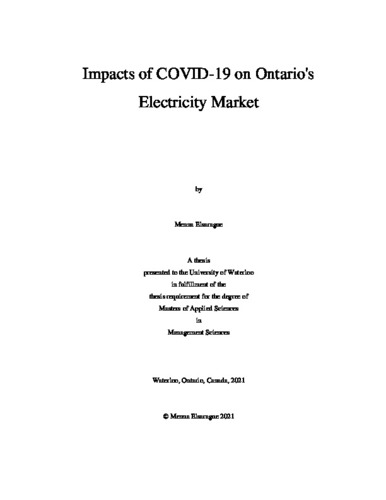| dc.contributor.author | Elsarague, Menna | |
| dc.date.accessioned | 2022-01-05 18:50:38 (GMT) | |
| dc.date.available | 2022-01-05 18:50:38 (GMT) | |
| dc.date.issued | 2022-01-05 | |
| dc.date.submitted | 2021-12-17 | |
| dc.identifier.uri | http://hdl.handle.net/10012/17833 | |
| dc.description.abstract | The COVID-19 outbreak has not only threatened global health but has also significantly affected the energy sector. Most countries around the world have faced sudden changes in the electricity load as a result of the strict measures that have been taken by mid-March 2020 to limit the spread of the disease. In order to investigate the patterns of changes in the electricity sector and to predict future load, machine learning (ML) techniques, such as descriptive data analytics, clustering, and forecasting methods, have been used widely in practice. This research, in particular, studies the impacts of the pandemic on Ontario’s electricity market by investigating changes in the electricity demand and prices. It further provides insights into incorporating ML methods for electricity load forecast and prescribes enhanced solutions for the pricing of electricity by assessing Ontario’s Market Renewal pricing system during COVID-19.
The analysis of demand and price changes due to the pandemic is presented through a comprehensive study of Ontario’s hourly electricity demand and hourly electricity prices (HOEP) considering annual, monthly, and daily granularity. Furthermore, the impact of the pandemic on load forecasting is investigated using a short-term Feed Forward Neural Network (FFNN) model, as in such rare events, load forecasting becomes more challenging and less accurate, causing high risks in the electricity system operation. Finally, the potential efficiency of Ontario’s Market Renewal during COVID-19 is assessed through a comparative analysis between Ontario’s current electricity market and New York’s electricity market, which has a comparable electricity system with respect to load and supply of electricity. In order to conduct this study, Ontario’s hourly electricity demand and price data, as well as the hourly weather data are used.
Our data-driven analysis shows that although the electricity demand dropped by 12% during the beginning of the pandemic in March, it started unexpectedly rising by the end of May 2020 to levels that exceeded the electricity demand in 2019. A similar pattern is observed for Ontario’s HOEP. The load forecast model performance is evaluated using the mean absolute percentage error (MAPE) during three distinct periods: pre-pandemic, beginning of the pandemic, and during the pandemic to illustrate how the sudden changes in the early stage of COVID-19 have affected the load forecast compared to other periods. The results of the forecast model show an overall MAPE of: 3.21%, 13.86%, and 4.23%, respective to the periods identified. Expectedly, the performance of the model during the pandemic is significantly affected. However, the model is still considered plausible, as a MAPE index between 10% and 20% is classified as good forecast accuracy. Finally, through the comparative analysis between the current Ontario’s uniformed price market and New York’s locational marginal price (LMP) based market, it is observed that Ontario’s current pricing system is less efficient and that consumers’ welfare could increase with an LMP pricing system, which will be part of the proposed Ontario’s Market Renewal. | en |
| dc.language.iso | en | en |
| dc.publisher | University of Waterloo | en |
| dc.relation.uri | https://www.ieso.ca/en/Power-Data/Demand-Overview/Real-time-Demand-Reports | en |
| dc.relation.uri | https://www.meteoblue.com/en/weather/archive/export/toronto_canada_6167865 | en |
| dc.relation.uri | https://www.nyiso.com/load-data | en |
| dc.relation.uri | https://www.nyiso.com/custom-reports?report=rt_lbmp_zonal | en |
| dc.relation.uri | https://www.ieso.ca/en/Power-Data/Data-Directory | en |
| dc.relation.uri | https://www.kaggle.com/nicholasjhana/eda-energy-demand-analysis | en |
| dc.relation.uri | https://towardsdatascience.com/clustering-electricity-profiles-with-k-means-42d6d0644d00 | en |
| dc.relation.uri | https://predictivehacks.com/k-means-elbow-method-code-for-python/ | en |
| dc.relation.uri | https://soumilshah1995.blogspot.com/2019/08/project-data-analysis-and.html | en |
| dc.subject | Impacts of COVID-19 on the electricity market | en |
| dc.subject | Electricity demand | en |
| dc.subject | Electricity price | en |
| dc.subject | Ontario's electricity market | en |
| dc.subject | New York's electricity market | en |
| dc.subject | Electricity demand forecasting | en |
| dc.subject | Machine learning forecasting techniques | en |
| dc.subject | Feed Forward neural network | en |
| dc.subject | Forecasting model evaluation methods | en |
| dc.subject | Mean absolute percentage error | en |
| dc.subject | Ontario's Market Renewal Program | en |
| dc.subject | Global adjustments | en |
| dc.subject | Electricity market operation | en |
| dc.subject | Electricity market efficiency | en |
| dc.subject | uniform price | en |
| dc.subject | locational marginal price | en |
| dc.subject | Rare events | en |
| dc.title | Impacts of COVID-19 on Ontario's Electricity Market | en |
| dc.type | Master Thesis | en |
| dc.pending | false | |
| uws-etd.degree.department | Management Sciences | en |
| uws-etd.degree.discipline | Management Sciences | en |
| uws-etd.degree.grantor | University of Waterloo | en |
| uws-etd.degree | Master of Applied Science | en |
| uws-etd.embargo.terms | 0 | en |
| uws.contributor.advisor | Pirnia, Mehrdad | |
| uws.contributor.affiliation1 | Faculty of Engineering | en |
| uws.published.city | Waterloo | en |
| uws.published.country | Canada | en |
| uws.published.province | Ontario | en |
| uws.typeOfResource | Text | en |
| uws.peerReviewStatus | Unreviewed | en |
| uws.scholarLevel | Graduate | en |

